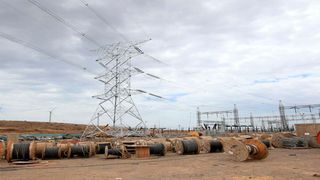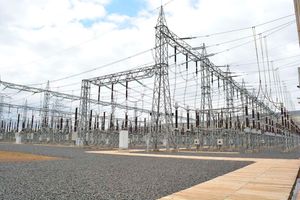
A pylon with power lines from the Lake Turkana Wind Power substation in Loiyangalani, Marsabit County in September 2018.
| REUTERSCompanies
Premium
Suswa power line: Ketraco in Sh13bn dilemma
What you need to know:
- Wind power project line already cost Sh18bn in idle power payments.
- Four pylons along the transmission line collapsed in December last year.
The government is caught in a dilemma over a Sh13 billion bill it faces should it keep the key Loiyangalani — Suswa power line off for a year to allow for comprehensive repairs.
The Kenya Electricity Transmission Company (Ketraco), the State agency in charge of power dispatch, would pay the amount for idle electricity produced as it repairs parts of the 430km-long 400 kilovolts (kV) transmission line from Loiyangalani to the Suswa substation.
It collapsed on December 16, cutting off the 300 megawatt (MW) Lake Turkana Wind Power (LTWP) plant in Marsabit.
Four pylon towers along the 200kv line collapsed at Longonot, prompting Ketraco and Kenya Power Company teams to carry out temporary repairs that restored power on January 1. This key line supplies about 17 per cent of Kenya’s total peak power demand.
The temporary repairs were fast-tracked after Kenya Power cautioned that Ketraco faced a daily charge of Sh39 million for idle power should the interruption extend beyond December 31 as per a power purchase agreement (PPA) it had signed with LTWP.
But with high risks of fresh mishaps due to a partially repaired transmission line, now Ketraco and the State find themselves in a quandary even as they seek a permanent fix.
Internal documents seen by the Nation show that it would take Ketraco staff one year to fix the line, which bucked just three years after it was constructed by a Chinese consortium.
Such a lengthy repair period would come at a huge cost for the State with Ketraco managers now recommending a special contractor option to restore the line as fast as possible and cut on the liabilities to LTWP.
“From the foregoing, it is in the national interest that a special method of procurement is employed to fast track the procurement of a new contractor to permanently restore Loyiyangalani Suswa line,” an internal memo following a January 20 meeting by Ketraco top managers stated.
Efforts to get a comment from Energy Cabinet Secretary Monica Juma were unfruitful by the time of going to press. The dilemma reignites debate on the shortcoming of the power purchase deal that the government signed with LTWP against the advice of the World Bank.
When Kenya approached the World Bank for a partial risk guarantee for the project, the multilateral lender told the Treasury that the deal was bad with the high risk of paying for idle power given the fact that the country had no experience in evacuating power from such a large-scale installation.
It also pointed out that Kenya’s commitment to deliver a transmission within 26 months was highly improbable and would result in penalties — a prediction that came to pass with the country being slapped with an Sh18.4 billion bill by LTWP for idle power between January 2017 and September 2018.
Sh10 billion was paid through taxes and Sh9.8 billion would be charged on consumers through a tariff review between June 2018 and May 2024.
The tariff review was, however, postponed on several occasions and is still hanging over consumers.
A special audit on the LTWP project saga by the Auditor-General revealed that while the company would charge KPLC for an incomplete transmission line, the government could not charge the company for delays in delivering the projects.
The audit said payments for the idle power began without independent review and LTWP selected the company that delayed the transmission line.
LTWP billed the government without installing a meter to measure the power being produced and without a Sacada system to confirm the quantity of power being generated by the turbines at any given time.
“Isolux Ingenieria and the consultant Kema both who had been procured by LTWP were key players in determining the success of the transmission line yet LTWP was the eventual beneficiary of the delays on completion of the project,” the Auditor-General stated.
The KPLC board approved the deal with Lake Turkana in November 2009, and in just four days after the board stamped it, Kenya Power Company sought the Energy Regulatory Commission (now Epra) to enter a power purchase agreement.
The deal was approved in just two days, showing the level of commitment from the government to facilitate the deal through a system of revolving doors that saw Kenya Power managers’ and Treasury officials trade places.
The deal had been hatched in 2007 when Mr Joseph Njoroge was the Managing Director of KPLC.
Mr Njoroge would change seats and become the Principal Secretary Ministry of Energy with a board position at Kenya Power and Energy and Petroleum Regulatory Authority (Epra), which was to approve proposals to pass Sh9.8 billion late payments to consumers.
Although the Head of Public Service Joseph Kinyua, who was PS Ministry of Finance in 2009, expressed concerns on costs, former Energy PS Patrick Nyoike wrote to Mr Njoroge to fast-track the PPA, saying project did not require a Cabinet approval as “it had full state support”.
Mr Kinyua was again involved when he revised the decision to have LTWP subsidiary Transco build the transmission line so that the government could own it, a decision which resulted in Isolux getting the project through a tender fronted by LTWP.
The deal was signed before LTWP and was even licensed to generate power, a concern that was raised by the Auditor-General. At the time, there was no transmission line, which meant that Kenya needed to build a 400kv line from Loyanglani to Suswa to serve the private company.
The company was given exclusive rights to survey project areas and invite tenders on behalf of Kenya Power when the law clearly stated that this needed to be done competitively.
The PPP was done without any competitive process with no justification as to why procurement laws were sidestepped.
The contract was initially given to Isolux Ingenieria of Spain, which went bankrupt after doing 51 per cent of the works and in 2018, it was given to the Chinese consortium of Nari Group and Powerchina Guizhou Engineering Company of China.
The project commenced in August 2014 and was completed in August 2018 at a cost of Sh22 billion, when initially it was supposed to cost Sh16.9 billion.
Kenya incurred an additional Sh3.1 billion to complete the line by Powerchina and Nari group which completed construction in 8 months and were paid Sh9.5 billion with a balance of Sh1.7 billion currently accruing penalties for late payment.
Ketraco was also still engaging subcontractors to complete foundation works at an additional cost of Sh1.5 billion.





